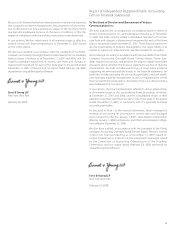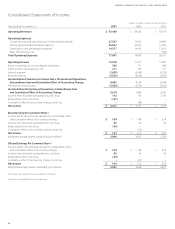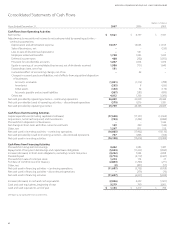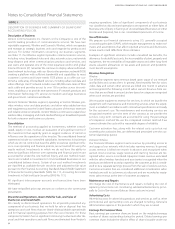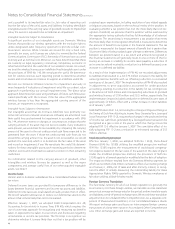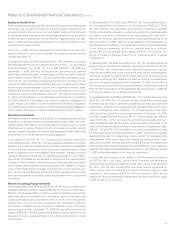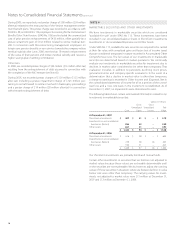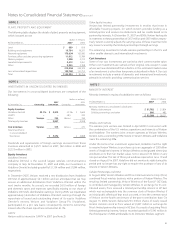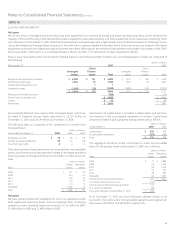Verizon Wireless 2007 Annual Report Download - page 48
Download and view the complete annual report
Please find page 48 of the 2007 Verizon Wireless annual report below. You can navigate through the pages in the report by either clicking on the pages listed below, or by using the keyword search tool below to find specific information within the annual report.Notes to Consolidated Financial Statements continued
46
sustained upon examination, including resolution of any related appeals
or litigation processes, based on the technical merits of the position. In
evaluating whether a tax position has met the more-likely-than-not rec-
ognition threshold, we presume that the position will be examined by
the appropriate taxing authority that has full knowledge of all relevant
information. The second step is measurement: a tax position that meets
the more-likely-than-not recognition threshold is measured to determine
the amount of benefit to recognize in the financial statements. The tax
position is measured at the largest amount of benefit that is greater than
50 percent likely of being realized upon ultimate settlement. Differences
between tax positions taken in a tax return and amounts recognized in
the financial statements will generally result in one or more of the fol-
lowing: an increase in a liability for income taxes payable, a reduction of
an income tax refund receivable, a reduction in a deferred tax asset, or an
increase in a deferred tax liability.
As a result of the implementation of FIN 48, we recorded adjustments
to liabilities that resulted in a net $79 million increase in the liability for
unrecognized tax benefits with an offsetting reduction to reinvested
earnings as of January 1, 2007. The implementation of FIN 48 also resulted
in adjustments to prior acquisitions accounted for under purchase
accounting, resulting in a reduction in the liability for tax contingencies
in the amount of $635 million and corresponding reductions to goodwill
and wireless licenses of $100 million and $535 million, respectively. The
implementation impact included a reduction in deferred income taxes of
approximately $3 billion, offset with a similar increase in other liabilities
as of January 1, 2007.
FASB Staff Position FAS 13-2, Accounting for a Change or Projected Change in
the Timing of Cash Flows Relating to Income Taxes Generated by a Leveraged
Lease Transaction (FSP 13-2), requires that changes in the projected timing
of income tax cash flows generated by a leveraged lease transaction be
recognized as a gain or loss in the year in which the change occurs. We
adopted FSP 13-2 effective January 1, 2007. The cumulative effect of ini-
tially adopting FSP 13-2 was a reduction to reinvested earnings of $55
million, after-tax.
Stock-Based Compensation
Effective January 1, 2006, we adopted SFAS No. 123(R), Share-Based
Payment (SFAS No. 123(R)) utilizing the modified prospective method.
SFAS No. 123(R) requires the measurement of stock-based compensa-
tion expense based on the fair value of the award on the date of grant.
Under the modified prospective method, the provisions of SFAS No.
123(R) apply to all awards granted or modified after the date of adoption.
The impact to Verizon resulted from the Domestic Wireless segment, for
which we recorded a $42 million cumulative effect of accounting change
as of January 1, 2006, net of taxes and after minority interest, to recog-
nize the effect of initially measuring the outstanding liability for Value
Appreciation Rights (VARs) granted to Domestic Wireless employees at
fair value utilizing a Black-Scholes model.
Foreign Currency Translation
The functional currency for all of our foreign operations is generally the
local currency. For these foreign entities, we translate income statement
amounts at average exchange rates for the period, and we translate assets
and liabilities at end-of-period exchange rates. We record these translation
adjustments in Accumulated Other Comprehensive Loss, a separate com-
ponent of Shareowners’ Investment, in our consolidated balance sheets.
We report exchange gains and losses on intercompany foreign currency
transactions of a long-term nature in Accumulated Other Comprehensive
Loss. Other exchange gains and losses are reported in income.
unit’s goodwill to its implied fair value (i.e., fair value of reporting unit
less the fair value of the unit’s assets and liabilities, including identifiable
intangible assets). If the carrying value of goodwill exceeds its implied fair
value, the excess is required to be recorded as an impairment.
Intangible Assets Not Subject to Amortization
A significant portion of our intangible assets are Domestic Wireless
licenses that provide our wireless operations with the exclusive right to
utilize designated radio frequency spectrum to provide cellular com-
munication services. While licenses are issued for only a fixed time,
generally ten years, such licenses are subject to renewal by the Federal
Communications Commission (FCC). Renewals of licenses have occurred
routinely and at nominal cost. Moreover, we have determined that there
are currently no legal, regulatory, contractual, competitive, economic or
other factors that limit the useful life of our wireless licenses. As a result,
we treat the wireless licenses as an indefinite-lived intangible asset under
the provisions of SFAS No. 142. We reevaluate the useful life determina-
tion for wireless licenses each reporting period to determine whether
events and circumstances continue to support an indefinite useful life.
We test our Domestic Wireless licenses for impairment annually or
more frequently if indications of impairment exist. We use a direct value
approach in performing our annual impairment test. The direct value
approach determines fair value using estimates of future cash flows asso-
ciated specifically with the licenses. If the fair value of the aggregated
wireless licenses is less than the aggregated carrying amount of the
licenses, an impairment is recognized.
Intangible Assets Subject to Amortization
Our intangible assets that do not have indefinite lives (primarily cus-
tomer lists and non-network internal-use software) are amortized over
their useful lives and reviewed for impairment in accordance with SFAS
No. 144, whenever events or changes in circumstances indicate that the
carrying amount of the asset may not be recoverable. If any indications
were present, we would test for recoverability by comparing the carrying
amount of the asset to the net undiscounted cash flows expected to be
generated from the asset. If those net undiscounted cash flows do not
exceed the carrying amount (i.e., the asset is not recoverable), we would
perform the next step which is to determine the fair value of the asset
and record an impairment, if any. We reevaluate the useful life determi-
nations for these intangible assets each reporting period to determine
whether events and circumstances warrant a revision in their remaining
useful lives.
For information related to the carrying amount of goodwill, other
intangibles and wireless licenses by segment as well as the major
components and average useful lives of our other acquired intangible
assets, see Note 9.
Income Taxes
Verizon and its domestic subsidiaries file a consolidated federal income
tax return.
Deferred income taxes are provided for temporary differences in the
bases between financial statement and income tax assets and liabilities.
Deferred income taxes are recalculated annually at rates then in effect.
We record valuation allowances to reduce our deferred tax assets to the
amount that is more likely than not to be realized.
Effective January 1, 2007, we adopted FASB Interpretation No. 48,
Accounting for Uncertainty in Income Taxes (FIN 48), which requires the
use of a two-step approach for recognizing and measuring tax benefits
taken or expected to be taken in a tax return and disclosures regarding
uncertainties in income tax positions. The first step is recognition: we
determine whether it is more likely than not that a tax position will be





